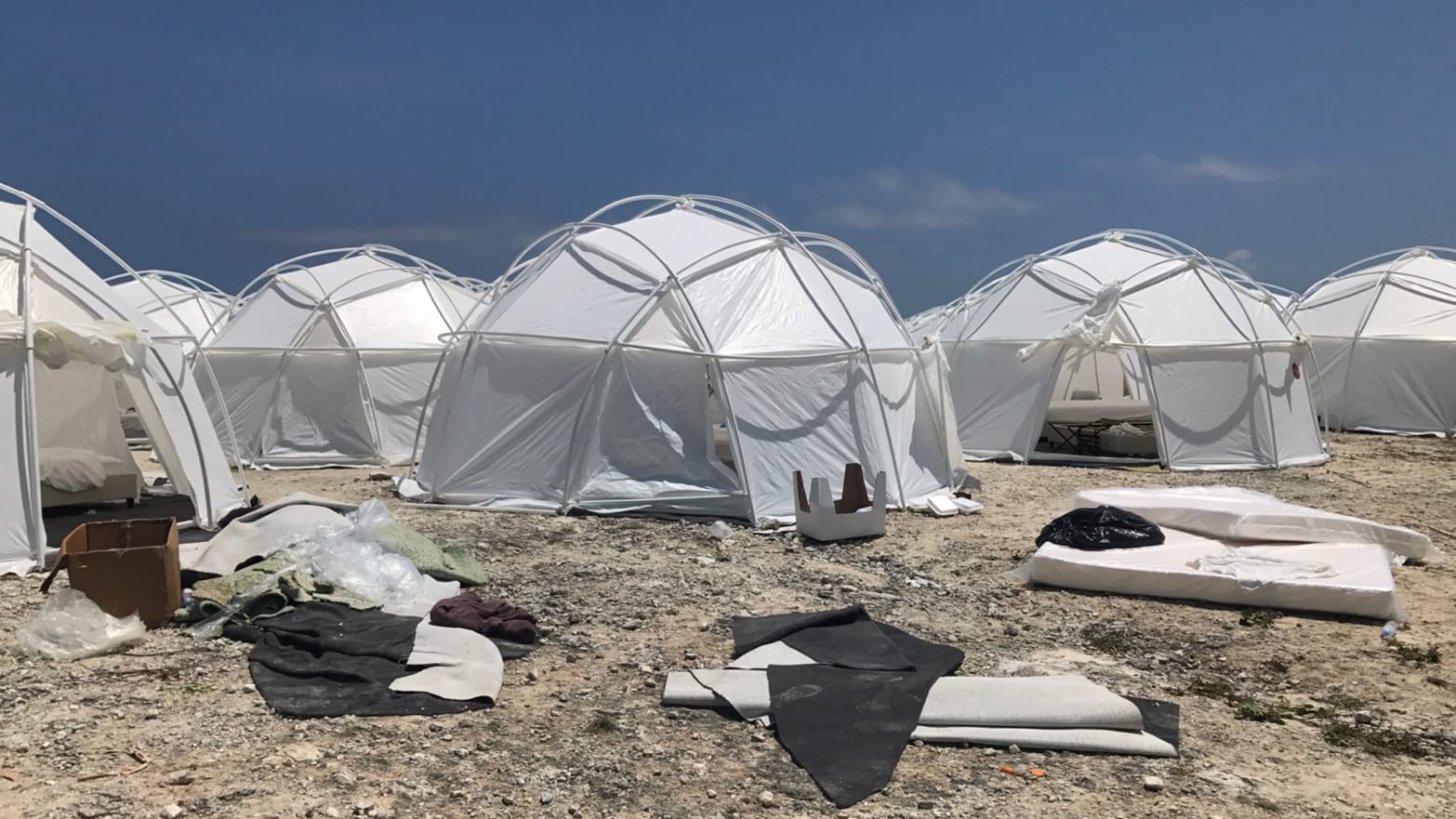Fyre Festival's Spiritual "Hype"
Fyre Festival was supposed to be “the cultural experience of the decade.” The brainchild of Billy McFarland, CEO of Fyre Media, Inc., and promoted by the rapper Ja Rule, Fyre Festival was sold as a “luxury music festival” to take place in Spring 2017 on the Bahamian island of Great Exuma
 Fyre Festival was supposed to be “the cultural experience of the decade.” The brainchild of Billy McFarland, CEO of Fyre Media, Inc., and promoted by the rapper Ja Rule, Fyre Festival was sold as a “luxury music festival” to take place in Spring 2017 on the Bahamian island of Great Exuma. Upon arrival, however, guests were disappointed by what they found, a disappointment that would soon give way to outrage. Lawsuits quickly followed claiming that McFarland had defrauded customers and investors for failing to deliver on what he and his team had promised to be a “luxury music” experience. In short, Fyre Festival was a magnificent disaster.
Fyre Festival was supposed to be “the cultural experience of the decade.” The brainchild of Billy McFarland, CEO of Fyre Media, Inc., and promoted by the rapper Ja Rule, Fyre Festival was sold as a “luxury music festival” to take place in Spring 2017 on the Bahamian island of Great Exuma. Upon arrival, however, guests were disappointed by what they found, a disappointment that would soon give way to outrage. Lawsuits quickly followed claiming that McFarland had defrauded customers and investors for failing to deliver on what he and his team had promised to be a “luxury music” experience. In short, Fyre Festival was a magnificent disaster.
Two years later, Fyre Festival continues to make headlines and lives infamously in the cultural imagination as a paragon of the maelstrom of uncritical-yet-aspirational millennials, capitalistic greed, and the power of technology through social media. In January 2019, Netflix and Hulu released documentaries detailing the scandal surrounding this highly-marketed festival. Just last month, Ja Rule announced that he was planning another Fyre Festival-like event, and, more recently, government officials have begun auctioning Fyre Festival merchandise in order to help defrauded customers.
A religious and historical analysis of the festival sheds light on a different, unexplored dimension of the event: the importance of material conditions for proper spiritual experience. Without the staging effect of the former, the latter might not be possible.
The interplay between the materialities of marketing and staging for the ostensibly immaterial purposes of “spiritual experience” has a long history in Christianity. For our purposes, it will be helpful to trace this phenomenon back to the revivals of the “First Great Awakening” in New England in the 1730/40s. Advertisers heralded the arrivals of itinerant preachers like British evangelical George Whitefield. Through pamphlets, signs, and word of mouth, news spread about the extravagant experiences of the revivals throughout the thirteen colonies. While the experience of listening to Whitefield and witnessing fantastical responses from the crowd did not lead to the conversion of all attendees, the power of advertising coupled with Whitefield’s evangelistic abilities to deliver an experience that consumed his listeners in body and mind commanded the attention of even his harshest detractors and skeptics. In short, Whitefield delivered on the hype surrounding the revivals. Upon seeing the crowds and marveling at the distance Whitefield’s voice traveled, the rationalist Benjamin Franklin offered to print Whitefield’s sermons despite remaining unconvinced of the content of his preaching. But while Whitefield delivered on the expectations that he cultivated among his audience, Billy McFarland and JaRule failed to deliver on the transcendence they marketed to their customers.
The advertisement for Fyre described the event as “on the boundaries of the impossible, Fyre Festival is an experience and festival, a quest.” Coupling this language with the allure of a remote island getaway and the endorsement of prominent social media figures as they frolicked on the beach helped to create an aura of attainable transcendence in which attendees could escape their quotidian, material realities, even if only for two weekends. In many ways, McFarland and Ja Rule weren’t just selling a music festival, but a pilgrimage. Fyre Festival invited its guests to “come” and “seek” an experience that “exceeds all expectations” and one “that’s hard to put to words.” This language not only enchanted the experience but also its geography. It suggested that physical travel and presence at the “event” were necessary elements of the kind of transcendence they were marketing. The island’s near-mythic status was further cemented by the advertisement’s inclusion of the site’s mysterious and alluring history: Colombian drug lord Pablo Escobar once owned the island. Together, these elements enchanted the product with a promise of transcendence.
More than anything, advertisements for Fyre detailed its lush material offerings: “the best in food, art, music, and adventure.” The festival’s website stated that guests would stay “in modern, eco-friendly, geodesic domes” in order to “unplug from the everyday and ignite your flame in the Exumas.” For food, Fyre promised “uniquely authentic island cuisine” in the form of “local seafood, Bahamian-style sushi, and even pig-roast.” Performances by famous bands like Major Lazer and Blink-182 headlined the festival. Advertisements also pitched proximity and access to social media celebrities such as models and socialites Kendall Jenner and Bella Hadid. The promise of these material luxuries shaped potential attendees’ expectations of transcendent experience, notably packaging them in forms that could be bought and sold. Immaterial experience—transcendence—depended on the delivery of precise material conditions.
The materiality of the festival also revealed the class dynamics behind this event. Who can afford these experiences offering transcendence? Despite being billed as a “luxury event,” Fyre Festival was pitched to everyone even if only a few could afford tickets which ranged from $500 to $1200 per ticket (not to mention the cost of travel and the ability to take up to two weeks off work). Every social media user who followed “social media influencers” like Jenner and Hadid was sold the Fyre Festival product, in some form or fashion. Even if someone could not afford to attend the event, being part of these influencers’ social media networks made followers aspire to be part of it. And so, while the transcendent experience itself hinged on the material offerings of the actual event, excitement and expectation—“hype”—for transcendence and spirituality suggested universal access, even if its “luxurious offerings” demanded exclusivity.
Fyre Festival’s ability to sell transcendence by way of specific material offerings to customers, coupled with the hype it created for this otherwise spiritual experience, highlighted how the cultivation of ostensibly immaterial phenomena such as “transcendence” or “spiritual experience” often depends on the proper arrangement of material realities.
Upon arrival, guests were welcomed with gravel instead of sandy beaches. With the geodesic homes being replaced by makeshift tents, guests could find no retreat from the same natural elements that awaited them on their return home. Without the bands, sounds intended to wrap guests in an atmosphere of transcendence were replaced by familiar noises of trucks carrying luggage and the confused scrambling of fellow guests. Cheese sandwiches in foam containers replaced authentic island food, the latter of which was to serve as a tactile reminder for guests of their pilgrimage. Disenchanted and disgruntled guests took to social media and flooded their followers’ feeds with complaints about the lack of medical personnel, event staff, internet service, and other “luxury” (or even basic) accommodations. Without social media, however, the scope of the event’s spiritual reach and its ultimate disappointment would be limited to a select few.
After Fyre Festival, event organizers posted on their website: “Fyre Festival set out to provide a once-in-a-lifetime musical experience on the Islands of the Exumas. Due to circumstances out of our control, the physical infrastructure was not in place on time and we are unable to fulfill on that vision safely and enjoyably for our guests.” Despite the promise of spiritual transcendence marketed to guests, Fyre Festival’s failure ultimately rested on its inability to deliver on its material promises of luxury homes, authentic island food, and famous bands. Perhaps future festival organizers, and others who might want to plan religious or spiritual events, could learn from Fyre Festival’s failures: “spiritual experience” cannot be realized apart from the proper arrangement of necessary material realities.
Image: The Fyre Festival's "luxury" accommodations. (Photo Credit: The Daily Beast)
| Author, Michael Baysa, is a PhD student at Princeton University’s Department of Religion in their Religion in the Americas subfield. His research focuses on the rise of theologically liberal networks in late eighteenth-century New England. |
Sightings is edited by Joel Brown, a PhD student in Religions in America at the Divinity School.


